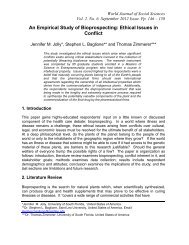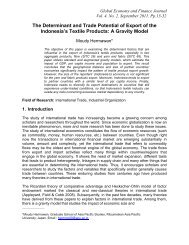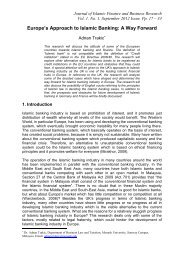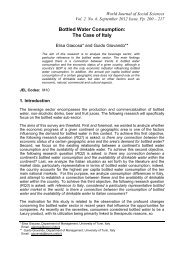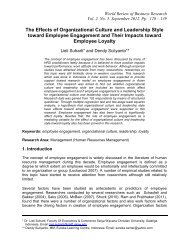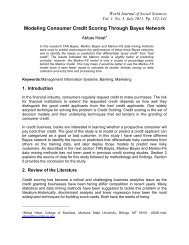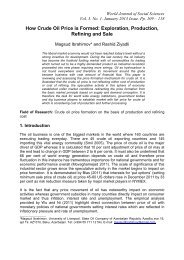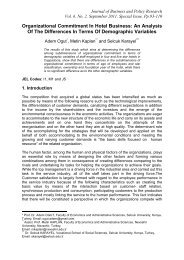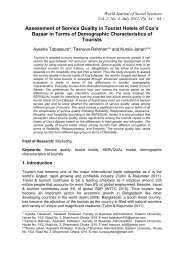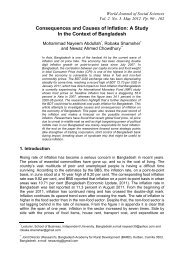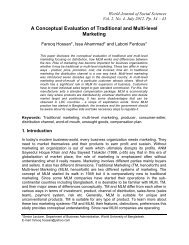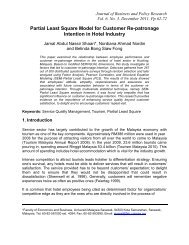Muhammad Faisol Chowdhury - Wbiaus.org
Muhammad Faisol Chowdhury - Wbiaus.org
Muhammad Faisol Chowdhury - Wbiaus.org
You also want an ePaper? Increase the reach of your titles
YUMPU automatically turns print PDFs into web optimized ePapers that Google loves.
<strong>Chowdhury</strong>4. Research Design4.1 The SurveyThe survey questionnaire was originally developed and validated by Human Capital,Ernst & Young Pvt. Ltd. India for the study of HR practices survey in Bangladesh in2006. This questionnaire was adapted for the 2010 study by adding relevantemergent HR practices which were not included in the original questionnaire. Theseemergent practices were identified by conducting an in-depth research and literaturereview on performance management system. The survey was systematicallydesigned to capture a representative view of performance management practices.Standard questionnaire-response approach was used. The questions weredistributed across a wide variety of items to collectively provide an exhaustivecoverage. A stratified sampling methodology was used to prepare a list of<strong>org</strong>anizations to be invited to participate in the survey. The criteria used forstratification were based on parameters which could substantially influenceperformance management practices of a country. The following three criteria werefinalized to stratify samples: (a) type of industry / sector, (b) ownership of the<strong>org</strong>anization, (c) stage of <strong>org</strong>anizational lifecycle.In this study, small businesses are constituted by 100 or fewer employees andmedium sized businesses range from 101 to 500 employees and large <strong>org</strong>anizationsby over 500 employees. As the lowest extremity for size, firms employing 10employees had been used because the research project is about performancemanagement system and such <strong>org</strong>anizations are expected to have a managementstructure.Out of 252 surveyed <strong>org</strong>anizations, 200 were local private <strong>org</strong>anizations and 52 wereMNCs. MNCs are considered as pioneer in practicing corporate governance in adeveloping country like Bangladesh where a little emphasis is given on practicingHRM by the local enterprises (Islam, 2006). It has been already accepted both indomestic and international market that employees are an important source ofcompetitive advantage for corporations (Peteraf 1993). It has also been found that ifPMS is linked to the overall business of a company, it may further enhance theperformance of the company (Pfeffer 1998). Moreover, due to the complexity ofmanaging people from different socio-economic and cultural background, it is arguedthat the way global employees are managed will also have a significant impact on afirm‟s economic outcome (Bjorkman & Xiucheng 2002). Thus, it has been noted thatfew MNCs know how to manage HR effectively in a dynamic internationalenvironment because best practices in one context do not always translate to othercontexts with differing socio-economic conditions and culture (Bouckaert & Halligan2008). However, in Bangladesh several MNCs are successfully in operation for thelast two decades (HR Practices Survey BD 2006). Despite the usual challenges ofimplementing ethnocentric HRM practices faced by MNCs operating in many foreigneconomy with different socio-economic and cultural orientations, most of the MNCsoperating in Bangladesh have been showing a fantastic performance by blending asignificant amount of local flavors with their home country HRM practices (Abdullah,Boyle & Joham 2010). As such, with the increasing presence of these MNCs withexcellent corporate governance and HRM practices in the economy, it is unjustified157



